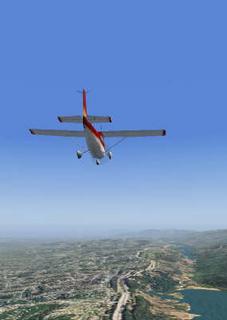Mystery Plane Sends NORAD on Wild Border Goose Chase
 Tucson, Arizona (United States):
Tucson, Arizona (United States):
A United States government aircraft caused alarm last Tuesday, when it crossed the border without following proper and standard Federal Aviation Administration procedures.
"About mid-day, we had two F-16s fly out of Davis-Monthan Air Force Base in Tucson and scramble to the border area to intercept the craft," said Master Sgt. John Tomassi, spokesperson for the North American Air Defense Command (NORAD).
Cessna did not respond
"The plane was a Cessna 182, I believe, coming up from the south. We scrambled to intercept because the plane wasn't responding to communications. So, our planes went to investigate."
He added, "They found out it was a government airplane and it was determined that it could be considered a non-threat. Our planes then went back home."
Tomassi said that when an aircraft enters the United States there are standard procedures that need to be followed and then when an aircraft does not follow those rules, NORAD will respond.
He was unable to answer why a U.S. government aircraft would not have followed those procedures.
Larry Tiffen, Nogales International Airport manager, said that the rules for crossing the border are fairly simple.
"Well," he said, "There has to be notification for U.S. Customs, and there has to be a flight plan filed. In this case it would be filed with the Prescott Flight Service Station" because of the jurisdiction.
"A flight plan includes the number of the airplane, where it's going, where it came from and the route and times it will take, plus or minus 10 minutes crossing the border.
"Then they have to have contract with the Tucson Approach Control. They should have what's called a Discrete Transponder Code. What that is, is a radar beacon reflector that transmits the identification of the airplane so that the radar people know who that is."
Laura Brown, FAA spokesperson, said that she did not know why the plane would not respond to transmission and that this craft caused an alert while it in was in the Air Defense Identification Zone, an area within 12 miles of the U.S. border with Mexico.
Oct 03, 2005
Julia Bishop, Nogales International, AZ
 Tucson, Arizona (United States):
Tucson, Arizona (United States):A United States government aircraft caused alarm last Tuesday, when it crossed the border without following proper and standard Federal Aviation Administration procedures.
"About mid-day, we had two F-16s fly out of Davis-Monthan Air Force Base in Tucson and scramble to the border area to intercept the craft," said Master Sgt. John Tomassi, spokesperson for the North American Air Defense Command (NORAD).
Cessna did not respond
"The plane was a Cessna 182, I believe, coming up from the south. We scrambled to intercept because the plane wasn't responding to communications. So, our planes went to investigate."
He added, "They found out it was a government airplane and it was determined that it could be considered a non-threat. Our planes then went back home."
Tomassi said that when an aircraft enters the United States there are standard procedures that need to be followed and then when an aircraft does not follow those rules, NORAD will respond.
He was unable to answer why a U.S. government aircraft would not have followed those procedures.
Larry Tiffen, Nogales International Airport manager, said that the rules for crossing the border are fairly simple.
"Well," he said, "There has to be notification for U.S. Customs, and there has to be a flight plan filed. In this case it would be filed with the Prescott Flight Service Station" because of the jurisdiction.
"A flight plan includes the number of the airplane, where it's going, where it came from and the route and times it will take, plus or minus 10 minutes crossing the border.
"Then they have to have contract with the Tucson Approach Control. They should have what's called a Discrete Transponder Code. What that is, is a radar beacon reflector that transmits the identification of the airplane so that the radar people know who that is."
Laura Brown, FAA spokesperson, said that she did not know why the plane would not respond to transmission and that this craft caused an alert while it in was in the Air Defense Identification Zone, an area within 12 miles of the U.S. border with Mexico.
Oct 03, 2005
Julia Bishop, Nogales International, AZ









